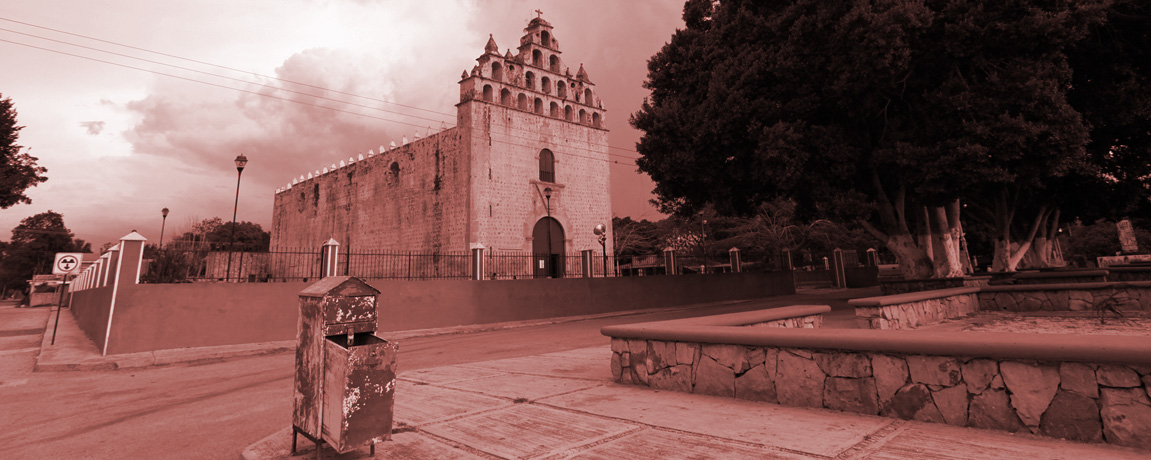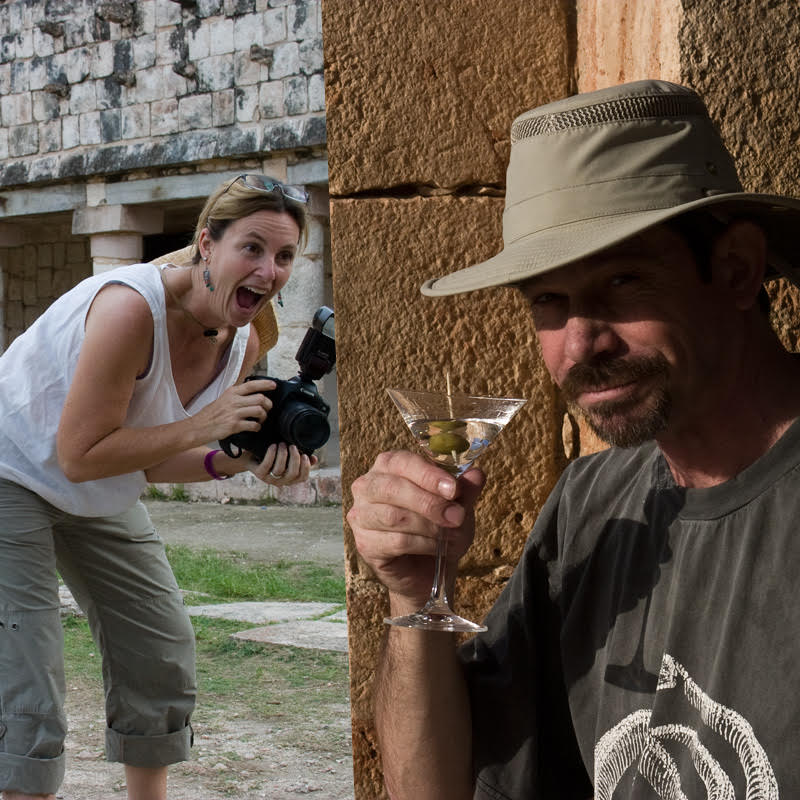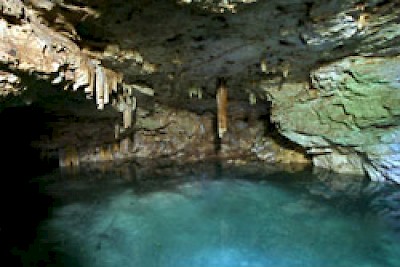Montezuma's Revenge
Many people who travel to the Yucatan or contemplate living here worry about the water. Almost every guide book and travel web site, and even the U.S. State Department, caution not to drink the water in Mexico or risk being yet another victim of the dreaded "Montezuma's Revenge", commonly known to those in the great white north as diarrhea. While there is no one-size-fits-all answer to any health issue, we'd like our readers to know our "up close and personal" experiences here.
But first a note about the phrase, "Montezuma's Revenge":
Moctecuzoma II (that's his real name) was the ruler of the Mexica (mistakenly called Aztec) empire until the Spaniards came along and whacked them. This highly developed yet brutal regime was located in the center of Mexico, where the city of the same name is today. That's a few thousand miles from Yucatan. Montezuma was undoubtedly aware of the Mayans, but he didn't have any pull with them. Everyone in North America was happy to see the Mexica get the whacking they deserved, along with their brooding little sellout, Montezuma. Therefore, it is our opinion that there is no such thing as Montezuma's Revenge in Yucatan, due to the jurisdictional technicality, and even some question of whether Montezuma deserves to be avenged anyway.
We have heard that the Mayans have as many words for diarrhea as Eskimos have words for snow. This suggests, we believe, why outsiders have so many diarrhea tales to tell after visiting here: this is a tropical environment and more of everything grows here more of the time. While those in the north are still dusting the snow off their mufflers, we're growing mangos down here. We're also growing all sorts of lively bacterial fauna. Think of it as Mayan snow.
The most important point we'd like to make is that nobody in Mexico or Yucatan likes diarrhea any more than you do. They go out of their way to avoid it - using bottled or purified water and washing foods thoroughly - especially in public restaurants and anywhere having to do with the tourism industry. They have to do this largely for the same reasons you have to shovel snow, not because of some innate defect in their engineering or sanitation.
Let's agree that there are really two different issues here. One is traveler's diarrhea and the other is living in the tropics.
The worst case of traveler's diarrhea we ever experienced was not in Mexico or Yucatan or even in the tropics. A few years ago, one of us spent an entire night praying (please, God) to die in their richly-appointed hotel bathroom located in the historic center of the lovely city of Florence, Italy. Was it the arugula? The tiramisu? The Perrier?
Anyone traveling anywhere in the world is exposing their exhausted, sightseeing selves to all kinds of unfamiliar stuff their intestinal tract may not approve of. Most who travel regularly take this for granted and carry some Pepto Bismol or Imodium in their Baggallini. But thousands of occasional and often careless tourists come to Yucatan every year only to return and report trouble with some long dead sniveler's revenge. We doubt all the others return to happily report they are diarrhea-free. And so, Mexico's reputation stands.
Living in the tropics of Yucatan is a different matter. It turns out that there are many causes of diarrhea, and we have not actually found water to be chief among them. When we moved here, over four years ago, we behaved as good travelers should, avoiding all but the tourist eating establishments, drinking and brushing our teeth with bottled water and avoiding fresh vegetables and fruits unless they had been washed in bottled or purified water.
There is a rather popular little blue bottle that looks like eye drops but contains a dark blue liquid. It is called Microdyne. It's sold where they sell fruits and vegetables. Add a drop of this stuff to a liter of tap water and stir, then soak your veggies or whatever in it for 15 minutes to eradicate those pesky fauna. We did this religiously for the first few months. Then we forgot sometimes. Then the little blue bottle drifted into the Tupperware bin under the sink and was forgotten. Before we even knew what we were doing, we were brushing our teeth in tap water and washing our faces in it. Then we even cooked with it. It was a slippery slope until we hit bottom and began to wonder what all this fuss over the water was about.
Did our bodies adapt to whatever it is that swims through the supposedly unholy water here?
The life cycle of water in the Yucatan suggests that if it were not for the tropical environment, there would be little trouble with diarrhea-causing bacteria. The rains fall on a slender layer of top soil and percolate into the 70 to 200 foot thick limestone pancake that nature left behind when it clobbered the region with the Chicxulub meteor about 65 million years ago. This limestone pancake is really more like an English muffin, with lots of nooks and crannies. By the time the rainwater reaches an underground river or cenote, it has been pretty well filtered. Contrast this with your normal reservoir or lake, where runoff, recreational use and airborne pollutants can really muck things up.
Merida's city water is delivered from this cenote water and arrives at your home where your pump sends it up to your tinaco, or holding tank, on your roof. Storing your own water on the roof not only provides the gravity for your water pressure, but it comes in handy if a hurricane or bad storm causes any flooding, which can temporarily contaminate water in the distribution system. Just turn off your pump until the flooding subsides and live out of your tinaco for a few days.
But woe to them who do not screw the lid down tight on their tinacos. Water by itself can't produce bacteria. For that you need food. If anything flies, falls or jumps into your tinaco, then the tropical environment takes over and you're going for a long ride on the porcelain bus.
We are exposed daily to the water here (even though we do prefer the taste of bottled water, which is what we drink). So if Yucatan water is really not the problem people make it out to be, why are there all those words for diarrhea in Mayan? Fact is, we do have occasional, minor bouts of diarrhea. What causes it? We can't always tell. We can eat at any number of road-side taco stands or cocinas economicas without ill effect, then drive home from a morning at the beach and yikes!
We think it just goes with the tropical territory (on the plus side, we don't get colds anymore). In other words, it's something we've learned to live with. That's not to say we live with intestinal pain or persistent symptoms. If the former, you have a form of traveler's diarrhea. You should take your Pepto, drink lots of water and rest. In our experience, Yucateco bacterium despise Pepto Bismol. If symptoms don't clear up after a day or so, then you may have parasitic diarrhea. Go to your local farmacia (pharmacy) and ask for Daxon. It's a three-day miracle regimen that will send those dudes packing. Of course, check with your doctor and all that. But here in Mexico, where you don't need a prescription for most things, you can just pick it up and try it on your own recognizance.
The kind of diarrhea we live with are those infrequent, one-time occurrences without abdominal pain that in most cases are simply stools that are less firm than usual. We call this tropical diarrhea. (See, now we have almost as many definitions for diarrhea as the Maya.) Here are some things we've learned that might help reduce the frequency of tropical diarrhea. Again, your mileage may vary and past performance is no guarantee of ... Well, you know:
We think it's not so much the water, but the microscopic critters that grow so easily in the tropics on fruits and vegetables. If you buy really fresh foods and eat them soon or keep them refrigerated, you will be avoiding problems. In any case, do wash the fruits and vegetables you eat and don't let food sit around in the open air for long.
Heat exhaustion causes diarrhea. If you are out in the backyard under direct sun in the afternoon exerting yourself in some typical nordic fashion (when you should be taking your siesta), you can probably expect a bad result.
Many foods take time for your body to get used to and your body may never get used to some of them. Ever heard the expression, "I love onions, but they don't love me"? Well, there are a multitude of fruits, vegetables, chilies, legumes, seafood and other exotic things in the Yucatan that you've never eaten. What are the chances that your body is going to appreciate all of them?
In some cases, food complications are well-known to the locals. For example, we used to have morning-after diarrhea when eating poblano chilies. We love poblano chilies, so we had accepted this experience as a fact of Yucatan life. Then one evening when we were describing our love for poblano chilies to a life-long resident of Merida, she matter-of-factly observed how you must remove the paper-thin skin before eating them or pay the consequences.
Oh...
Local traditions have also taught us the three most important ingredients for a healthy diet in the Yucatan: jugo de limone (lime juice), ajo (garlic) and chili de habanero. One or more of these ingredients are found in most Yucatecan cuisine and it doesn't take a waterworks engineer to figure out that just maybe they help to prevent the growth - and probably outright kill - those pesky little organisms nurtured by our tropical paradise.
We hope this article helps those in search of intestinal fortitude during their stay in Yucatan. We only have one request: if you come to the Yucatan and get diarrhea, please don't call it Montezuma's Revenge. Find out exactly what kind of diarrhea you have and learn the Mayan word for it.












Comments
Shay 8 years ago
Just found this article and having lived in Quintana Roo for 8 years, I will say preparing your own food is always best. The handling and disinfection protocol in restaurants anywhere can make you sick. Adding a tablespoon of Clorox to the water you wash and rinse dishes in kills e-coli and many other waterborne bacteria. Cysts, cryptosporidium and giardi, require carbon filtration from your tinaco to inside your home. .. and this is just for water to bathe in. Once or twice a year do a chlorine shock flush of all your pipes to kill fecal coliform. Purchasing a reverse osmosis system is well worth the investment to not buy bottled water.
I have discovered that these steps and precautions make living in the tropics healthier.
Reply
Sam Durfee 9 years ago
I loved your lead in to the actual culprits; or reasons one may get diarea! Great use of sarcasam and humor! Great food for thought also. I have noticed this problem with in our state of Michigan it's self while drinking water, eating food in a new destination while camping. Great job!
Reply
lizzy 13 years ago
I have never had so many giggles and outright guffahs reading about the quick step. thanks for the info and hardy amusement
Reply
Miguel Ãngel Quiñonez 14 years ago
Hola,
Don't forget TREDA. You can find it in any farmacia and it works really well for most people.
I've had doctors prescribe it along with Cipro for many bad cases but it usually works fine just by itself.
Reply
hammish 15 years ago
The name Montezuma´s revenge is sort of like a joke, so you should call it that, don´t need to get all technical about it.
Reply
Jeff 16 years ago
Been there! Done that! e kuu ta le tirix ta!
Reply
Bill Hennessy 17 years ago
Pepto never seem to do me any good. I had to give up a good job in Mexico because I just could not eat the food without getting sick. Maybe I'm just sensitive to it from getting real sick in with it in Vietnam. The last time I was in Mexico for any length of time was 2 years ago in Cancun for 2 months. I found a good restaurant, and brought from home some of my own food.
However If you are going to stay for a long time one needs to find another source of food. I never got sick from eating at Sanborn's or 100% Natural. I also never got sick from something I cooked myself. I guess going to Wal-Mart and fixing your own food is the key
Reply
Suzette 17 years ago
Carlos you probably got sick from the M.S.G. in the KFC chicken . Most of their food is loaded with it (as is a lot of fast food, french fries etc.) as it is a common preservative. The only time I ever had a major stomach upset in Mexico it turned out to be the M.S.G. (monosodium glutamate) in the hamburgers and fries in a reputable restaurant in Melaque. I ate lots of fish the last time I was in Progreso I and never had a reaction. Even in Canada I always carry Pepto or immodium with me because many retaurants have M.S.G. in their foods and the cooks and the waiters say that there is none in their food because they don't add it, but lots of it comes prepared and they don't look at the labels. Some products that contain M.S.G. may have it but it is not named and is just listed as spices. There are also some other preservatives that can cause a stomach reaction.
Reply
Carlos Daniel Gallegos 17 years ago
Like many U.S. citizens, when I told my friends I was going to Mexico, they warned me of drinking the water and eating in non tourist locations. I've eaten at resturants in Monterrey, NL; I've eaten at food stands along the Gulf Coast as I rode the bus ADO from Texas to Merida and back. I've eaten at the many mercados in Merida. The only place I got sick was the KFC on Circuito Colonias back in August 2003. Guess the food was not cleaned or handled properly. I always thought being of Mexican decent from my father, that Monteczuma would not curse me. :-) Ariadna always cautioned me about drinking the tap water. I did brush my teeth, washed my vegetables and dishes with tap water. For drinking water, I bought the large jugs off the trucks or the small bottles from the stores as I explored Merida. All I have to say is: Provecho when eating. There is risk in every thing. Enjoy life.
Reply
The Dark Side of Yucatan 18 years ago
[...] We have written about many of the challenges of living in Yucatan, including the heat and humidity, Moctezuma’s Revenge, insects, the language barrier and city traffic, but we try to approach these subjects in a way that is useful to potential expatriates, not as reporters trying to sell papers. [...]
Reply
Giggles 18 years ago
Im going to still call it Montezuma's Revenge water. But it is a good idea to take Pepto Bismol. I still haven't changed my mind about the myth I still believe in it. But you did make a point about it. Good Job.
Reply
(0 to 11 comments)Next »